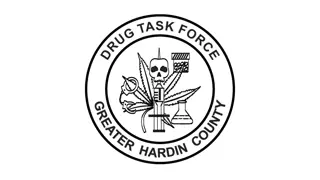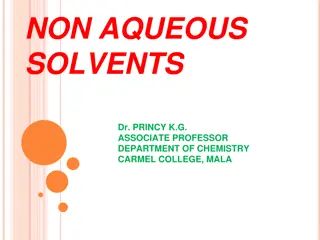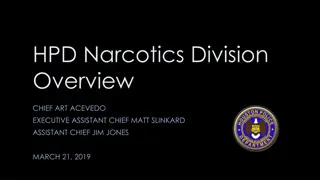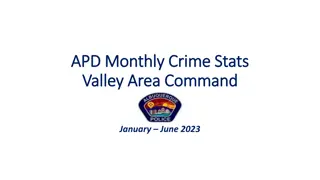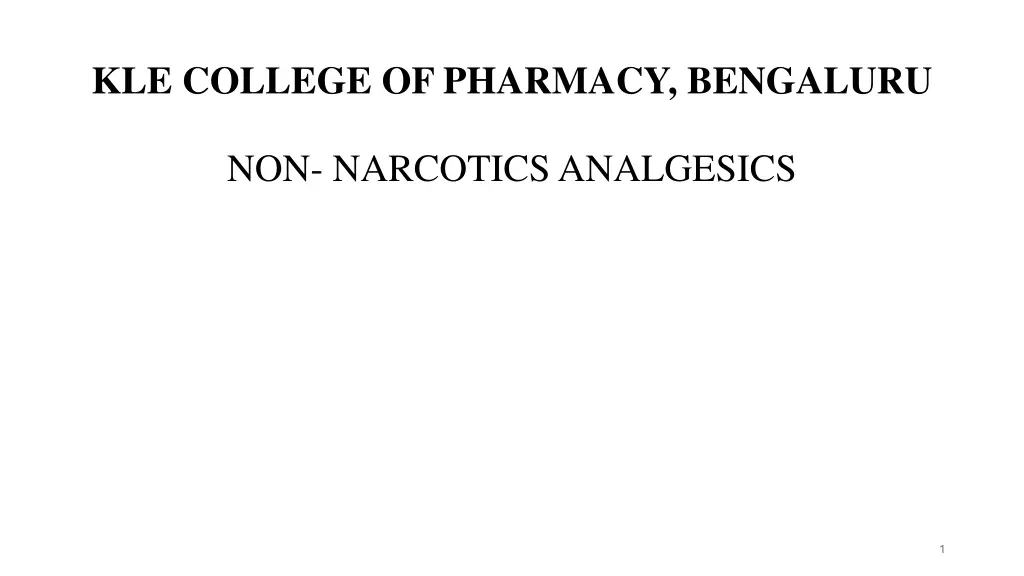
Understanding NSAIDs and Their Classification
Explore the world of non-narcotic anti-inflammatory drugs (NSAIDs) used to relieve pain, reduce inflammation, and lower fever. Learn about their mechanism of action, classification, and various types available in the market.
Download Presentation

Please find below an Image/Link to download the presentation.
The content on the website is provided AS IS for your information and personal use only. It may not be sold, licensed, or shared on other websites without obtaining consent from the author. If you encounter any issues during the download, it is possible that the publisher has removed the file from their server.
You are allowed to download the files provided on this website for personal or commercial use, subject to the condition that they are used lawfully. All files are the property of their respective owners.
The content on the website is provided AS IS for your information and personal use only. It may not be sold, licensed, or shared on other websites without obtaining consent from the author.
E N D
Presentation Transcript
KLE COLLEGE OF PHARMACY, BENGALURU NON- NARCOTICS ANALGESICS 1
CONTENTS Introduction Classification of NSAIDs Mechanism of Inflammation and NSAIDs Pharmacological action Pharmacokinetics Adverse Drug Reactions (ADR) Clinical uses Precautions and Contraindications Drug Interactions Reference 2
INTRODUCTION Non-narcotics also called Non-steroidal anti-inflammatory drugs (NSAIDs) or Non-Opioid Analgesics. ACTIONS- Analgesic- Drugs curing fever Antipyretic- Drugs curing pain Anti-inflammatory- Drugs curing inflammation NSAIDs are a class of medications commonly used to relieve pain, reduce inflammation, and lower fever (mild to moderate pain and fever) NSAIDs don t depress CNS, don t produce physical dependence , have no abuse liability and are weaker analgesic instead morphine shows all characteristics. 3
Mainly NSAIDs act on peripheral pain mechanism. NSAIDs produces anti-inflammatory action means it acts against the inflammation. What s inflammation? It s a complex biological responses of body tissues to harmful stimuli, such as pathogens, damaged cells or irritants. Or It is a condition in which part of the body becomes reddened, swollen, heat and painful, especially as a reaction to injury or infection. 4
CLASSIFICATION of NSAIDs A A. Non-selective COX inhibitors: 1. Salicylates: Aspirin 2. Propionic acid derivatives: Ibuprofen, Naproxen, Ketoprofen, Flurbiprofen 3. Fenamate: Mefenamic acid 4. Enolic acid derivatives: Piroxicam, Tenoxicam 5. Acetic acid derivatives: Ketorolac, Indomethacin, Nabumetone 6. Pyrazolone derivatives: Phenylbutazone, Oxyphenbutazone 5
B. Preferential COX-2 inhibitors: Nimesulide, Diclofenac, Aceclofenac, Meloxicam, Etodolac C. Selective COX-2 inhibitors: Celecoxib, Etoricoxib, Parecoxib, Rofecoxib D. Analgesic-antipyretics with poor anti-inflammatory action: 1. Paraamino Phenol derivative: Paracetamol (Acetaminophen) 2. Pyrazolone derivatives: Metamizol (Dipyrone), Propiphenazone 3. Benzoxazocaine derivative: Nefopam 6
MECHANISM OF INFLAMMATION & NSAIDs Injury Releases Phospholipase A2 enzyme Arachidonic acid COX (Cyclooxygenase) 5-LOX (Lipoxygenase) Leukotriens (LTs) COX-1 COX-2 PGs, PGI2 (prostacyclin) Induce pain and fever PGs (Prostaglandins) Secretion of protective gastric mucus. Regulation of gastric acid. TxA2 (Thromboxane) Vasoconstriction. Increase platelets activation and aggregation. Inflammation, pain & fever Vasodilation Decrease of platelet aggregation 7
Anti-inflammatory (reduce or inhibit inflammation) Now, why this Non-Steriodal? Anti-inflammatory Non-steroidal (non-opioid) Steroidal (opioid drugs) Used for less severe types of pain Not depress CNS and act peripheral but also raise pain threshold in CNS More commonly employed and many are OTC drugs Example: Aspirin, Ibuprofen. Used for severe type of pain Depress CNS They have more adverse or side effects Example: Morphine, Codeine. 8
General mechanism: inhibit NSAIDs COX enzyme Decrease in the production of inflammation mediators PGs, TxA2, PGI2, etc Decrease in pain, fever, and other responses 9
Non-selective COX inhibitors- These are those drugs which inhibit the cox enzyme (both 1 and 2, but mostly 1st. 1. Aspirin: Also known as Acetyl Salicylic acid It is a prototype drug After administration in body it converts rapidly into salicylic acid which is responsible for most of the action It is one of the oldest analgesic-anti-inflammatory drugs Regular use or high consumption of aspirin leads to death or other side effects. 10
Pharmacological action of Aspirin: 1. Analgesic: : Reduces mild to moderate pain by inhibiting the enzyme COX, which decreases the production of PGs responsible for pain sensation. 2. Anti-pyretic action: Aspirin reduces body temperature in fever but doesn t affect normal body temperature By inhibiting both COX-1 and COX-2, it reduces PG synthesis in the hypothalamus and resets the hypothalamic thermostat and rapidly reduces fever by promoting heat loss (sweating, cutaneous vasodilation), but doesn t decrease heat production. 11
3.Anti-inflammatory: Lowers inflammation by blocking the COX-2 enzyme, reducing prostaglandins synthesis that drives the inflammatory response. 4. GIT: : Irritate gastric mucosa and cause peptic ulcer Increase risk of GI bleeding It also stimulates CTZ (Chemoreceptor Trigger Zone). 5. Blood: Irreversibly inhibits COX-1 in platelets, preventing the formation of Thromboxane A2, which reduces platelet aggregation and blood clot formation. 12
6. CVS: At low doses, reduces the risk of heart attack, strokes, and other cardiovascular events in patients at high risk. It prevents the formation of clots in arteries (thrombosis) that can block blood flow to the heart or brain. 7. Respiration: Salicylates (aspirin) increase consumption of oxygen by skeletal muscles. As a result, there is increased CO2 production. Excess of aspirin usage may lead to hyperventilation. 13
8. Urate excretion: Aspirin can decrease the kidney s ability to excrete uric acid, leading to higher levels of uric acid in the blood. Elevated uric acid levels due to decreased excretion can contribute to the development of gout. 9. Metabolic effects: In high doses, aspirin can lead to more acids in the blood, which can make the blood more acidic (metabolic acidosis) Glucose utilisation is increased resulting in fall in blood glucose level ( especially in diabetic patients) 14
PHARMACOKINETICS Absorption: Well absorbed from the stomach and small intestine. Distribution: Widely distributed throughout the body. About 80% bound to plasma protein. Entry into brain is slow because of its less lipid solubility Easily crosses placenta. 15
Metabolism: Rapidly deacetylated in the gut wall, liver, plasma, and other tissues to release salicylic acid (active form) Excretion: Excreted in urine. Plasma half life is 15-20 minute and it is dose dependent. 16
ADVERSE DRUG REACTIONS 1. At analgesic dose Nausea, vomiting, stomach pain, increased blood loss in stools. 2. Gastric mucosal damage and peptic ulceration. 3. Hypersensitivity reaction s include rashes, asthma, urticaria, swelling (angioedema), idiosyncrasy. 4. At anti-inflammatory doses At higher doses it produce the syndrome called salicylism, tinnitus, dizziness, vertigo, headache, hyperventilation and electrolyte imbalance. 5. Impaired kidney function and acute kidney injury. 6. Reye s syndrome. 7. In CVS Rise in BP, risk of MI, CHF 8. Thrombocytopenia. 9. Leukopenia. 17
CLINICAL USES 1. As analgesic for headache, backache, toothache, joint pain. 2. As anti-inflammatory for dysmenorrhea, myalgia. 3. As antipyretic for fever. 4. In rheumatoid arthritis. 5. In osteoarthritis. 6. Heart attack and stroke. 7. Prevent thromboembolism. 18
PRECAUTIONS AND CONTRAINDICATIONS Contraindicated in patients with peptic ulcer, bleeding tendencies, children suffering from chicken pox/influenza. In chronic liver failure. Avoided in diabetes. Aspirin should be stopped 1week before elective surgery. Aspirin should be avoided by breast feeding mother. Not recommended during pregnancy, particularly in 1st and 3rd trimester. 19
DRUG INTERACTIONS Aspirin should not be given with warfarin risk of bleeding. Methotrexate increased toxicity. Antidepressants increase risk of GI bleeding. Pain killer (Ibuprofen, diclofenac) increase risk of stomach bleeding. Acetazolamide and Ammonium chloride decrease renal elimination. ACE inhibitors (Lisinopril, Enalapril) and Angiotensin 2 receptor blockers ( Losartan, Valsartan) reduce their effectiveness in lowering BP. 20
REFERENCES 1. Tripathi, K. D. Essentials of Medical Pharmacology. 7th ed. New Delhi: Jaypee Brothers Medical Publishers, 2013. 2. Sharma, H.L., & Sharma, K.K. (2020). Principles of Pharmacology (4th ed.). Paras Medical Publishers. 21
Thank You 22










